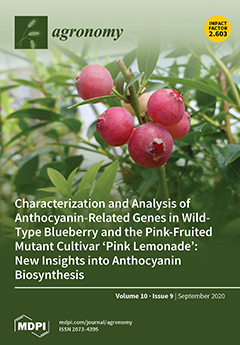Fusarium head blight (FHB) is a complex disease of cereals caused by
Fusarium species, which causes severe damages in terms of yield quality and quantity worldwide, and which produces mycotoxin contamination, posing a serious threat to public health. In the study presented herein,
[...] Read more.
Fusarium head blight (FHB) is a complex disease of cereals caused by
Fusarium species, which causes severe damages in terms of yield quality and quantity worldwide, and which produces mycotoxin contamination, posing a serious threat to public health. In the study presented herein, the antifungal activity against
Fusarium culmorum of chitosan oligomers (COS)–amino acid conjugate complexes was investigated both in vitro and in vivo. The amino acids assayed were cysteine, glycine, proline and tyrosine. In vitro tests showed an enhancement of mycelial growth inhibition, with EC
50 and EC
90 effective concentration values ranging from 320 to 948 µg·mL
−1 and from 1107 to 1407 µg·mL
−1 respectively, for the conjugate complexes, as a result of the synergistic behavior between COS and the amino acids, tentatively ascribed to enhanced cell membrane damage originating from lipid peroxidation. Tests on colonies showed a maximum percentage reduction in the number of colonies at 1500 µg·mL
−1 concentration, while grain tests were found to inhibit fungal growth, reducing deoxynivalenol content by 89%. The formulation that showed the best performance, i.e., the conjugate complex based on COS and tyrosine, was further investigated in a small-scale field trial with artificially inoculated spelt (
Triticum spelta L.), and as a seed treatment to inhibit fungal growth in spelt seedlings. The field experiment showed that the chosen formulation induced a decrease in disease severity, with a control efficacy of 83.5%, while the seed tests showed that the treatment did not affect the percentage of germination and resulted in a lower incidence of root rot caused by the pathogen, albeit with a lower control efficacy (50%). Consequently, the reported conjugate complexes hold enough promise for crop protection applications to deserve further examination in larger field trials, with other
Fusarium spp. pathogens and/or
Triticum species.
Full article


